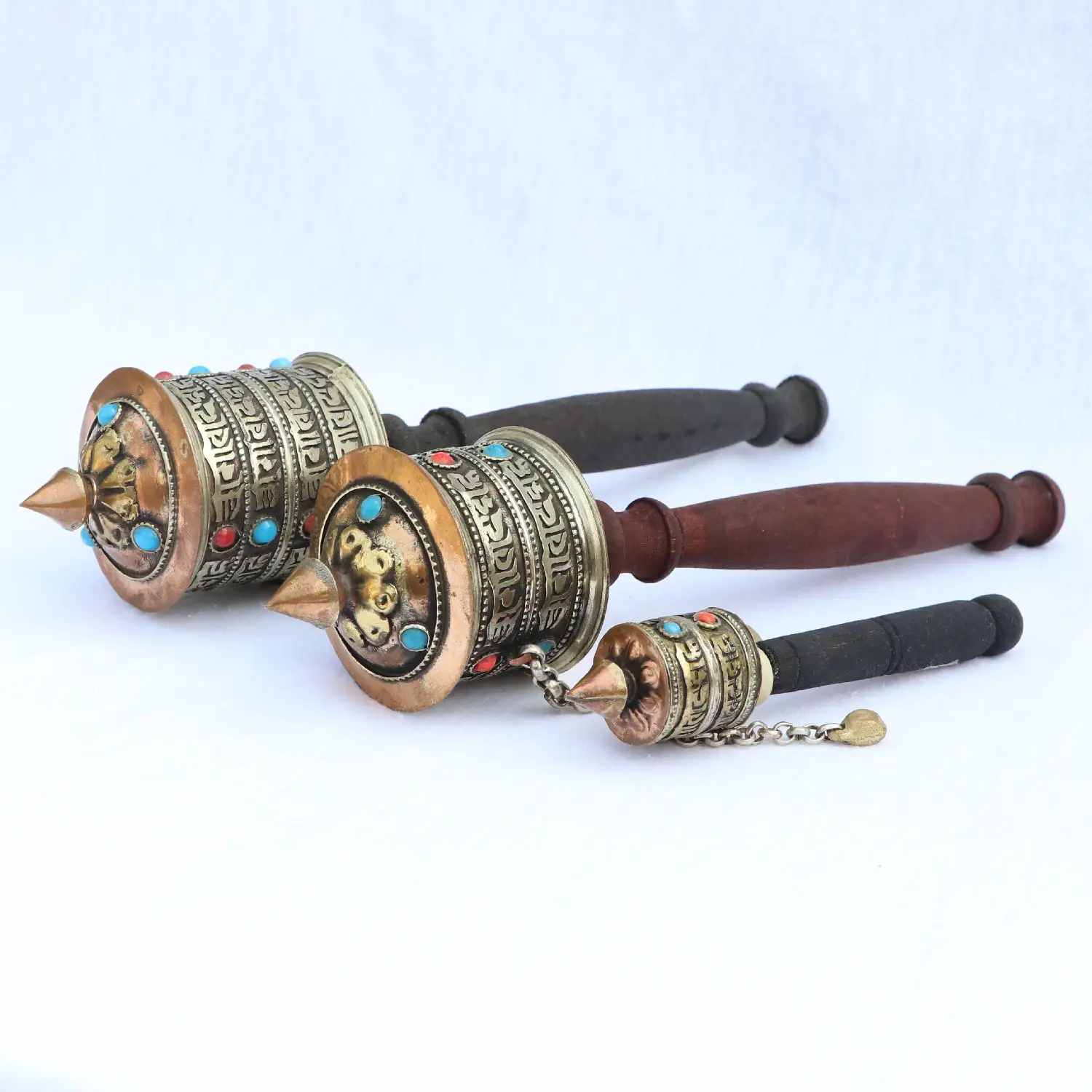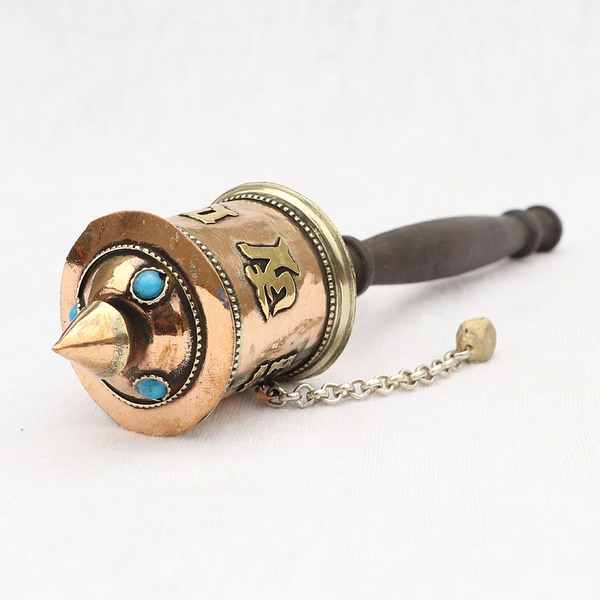What spins around and is a significant ritual accessory used by Buddhists in their ritual and cultural practices? That’s right, it’s prayer wheels. These are iconic Buddhist accessories that Buddhists and followers of Tibetan culture use across the globe. Now, you can find these prayer wheels in many sizes and forms. However, regardless of their specifics, the common purpose of these accessories is that they can be spun and are highly spiritually significant. But the question here is, what is the role of hand prayer wheels in spiritual practice?
In this blog, we talk about the symbolism of prayer wheels and their role of prayer wheels in practice. So, without any further ado, let’s get started!
Spiritual Significance of Prayer Wheels
Prayer wheels have been used for many years in Buddhist and Tibetan cultures. Therefore, the symbolism behind prayer wheels is rich and significant. Some of the key symbols associated with prayer wheels are as follows.
Mantras and Sacred Texts
The core symbolism behind prayer wheels is the mantras and sacred texts inscribed in them. These mantras are typically written in Sanskrit and Tibetan script. The specifics of the mantra vary depending on the inscribed mantra. Regardless, they carry spiritual power and positive energy.
Wheel Rotation
Along with the mantra inscribed in the hand of Tibetan prayer wheels, the rotation of these wheels also has spiritual importance. The clockwise rotation of the prayer wheels is considered auspicious and aligned with the natural order of the universe. Furthermore, the turning of the prayer wheel symbolizes the turning of the wheel of Dharma. It also signifies the progression towards enlightenment.
Connection to Compassion
Prayer wheels are typically adorned with the depiction of various Buddhas and Bodhisattvas. They are enlightened beings who have chosen to remain in the cycle of rebirth to help all sentient beings. Therefore, the act of turning the prayer wheel is seen as the expression of compassion and invoking blessings.
Purification and Transformation
The turning of these wheels is also seen as the symbol of the commitment to purify the negative karma. Furthermore, it also signifies the transformation of one’s negative karma into a positive one. This transformation represents the nature of life, death, and rebirth, along with the potential for spiritual evolution.
Unity of Mind, Body, and Speech
The turning of these wheels also symbolizes the unity of mind, body, and speech. The physical act of turning the wheel is associated with the speech and mental focus to create a holistic approach to devotion.
These are just some of the various spiritual significance of prayer wheels. Besides these, the specific meaning can vary depending on the associated sect of Buddhism and culture along with types of prayer wheels. That said, the core meaning does not change; the various aspects are added to the base significance of the prayer wheels.
What is the Role of the Hand Prayer Wheel in Spiritual Practice?
Now that we know what the spiritual significance of these prayer wheels is, let’s talk about the role of hand prayer wheels. The prayer wheels play a vital role in spiritual practice, specifically within the context of Tibetan Buddhism and other associated traditions. So, what are the roles of prayer wheels in spiritual practice? Some of the roles of prayer wheels in spiritual practice are as follows.
Meditative tool
One of the primary roles of the hand prayer wheel is to serve as a meditative tool. Spiritual practitioners spin the wheel while reciting the sacred mantras to enhance their focus and overall state of mind. Furthermore, the repetitive motion of turning the wheel can become rhythmic, which enhances the focus and uplifts the concentration.
Mantra Recitation
Another key significance of prayer wheels in spirituality is during the process of mantra recitation. These accessories are inscribed with sacred mantras and prayers. As the wheel turns, so do the mantras. Spiritual practitioners believe that the act of chanting the mantras provides spiritual benefits and purifies negative karma. Furthermore, practitioners also believe that using this accessory accumulates positive karmic points.
Mindfulness and Presence
Another significance of the hand prayer wheel in spiritual practice is during mindfulness practice. Using this accessory allows practitioners to focus on the act of rotation and recitation of the mantras. Furthermore, it also allows practitioners to keep a presence of mind during meditation. This effect can go beyond the scope of meditation practice sessions and influence the person’s daily life.
Purification of Negative Karma
Another role of the hand prayer wheel is in the purification of negative karma. As you engage in the ritual of turning the wheel, you can reduce the ill effect of the past negative karma. Therefore, you can create a positive spiritual momentum in your life by using the spiritual wheel.
Cultivation of Compassion
The hand prayer wheel is often seen as a tool for cultivating compassion. The practice of using a prayer wheel is accompanied by heartfelt wishes for well-being. The turning of the wheel becomes an expression of compassion and commitment to the welfare of others. It also acts as a wish for the kindness and well-being of others.
Symbolic Alignment with Dharma
The clockwise rotation of the Buddhist prayer wheel is symbolically aligned with the turning of the wheel. The turning of the Dharma wheel represents the teachings of Buddha. Furthermore, the alignment signifies the commitment to the path of enlightenment and the pursuit of spiritual wisdom.
These are just some of the roles of the hand prayer wheel in practice. Besides this, there can be many other roles. Regardless, from what we mentioned so far, you can guess the basic gist regarding the roles.
Tips for Incorporating Hand Prayer Wheels into Personal Practice
After knowing the role of prayer wheels let’s talk about some tips for you to incorporate prayer wheels into personal practice. Some of the tips are as follows.
Design a specific area in your home to foster a sacred environment for your practice
- Form a consistent routine to use prayer wheels
- Set a clear intention for practicing using the prayer wheel
- Using the hand prayer wheel, recite the inscribed mantra
- Coordinate the rotation of the mantra with slow and mindful breathing
- Connect the spiritual significance with the prayer wheel
- Pair it with other rituals
These are just some of the ways to incorporate prayer wheels into your daily life. Besides this, you can use your methods to incorporate this religiously significant Tibetan accessory into your daily life.
Conclusion
Prayer Wheels are an integral part of Tibetan and Buddhist culture. These prayer wheels are used for various spiritual and religious purposes, have deep significance, and play a vital role in spiritual activity.
In this blog, we covered just some of the role of the hand prayer wheel in spiritual practices, along with its significance. Regardless, we hope you found this helpful. If you want further insights into the world of prayer wheels, and other spiritual accessories, do check out some of our other blogs. If you want to purchase the best prayer wheels for your retail shop, please visit us at Nirvana Mala, home to some of the best handicraft men in Nepal. Thank you for reading till the end.
FAQs on the Spiritual Role of Prayer Wheels in Spiritual Practice
Q: What is the significance of the clockwise rotation of the prayer wheel?
A: The clockwise rotation aligns with the natural order. Therefore, it is considered auspicious in Tibetan Buddhism, and it symbolizes the turning of the wheel of Dharma and the progression towards enlightenment.
Q: What is the purpose of the mantras inscribed on the prayer wheel?
A: The mantras carry spiritual power and positive energy. Reciting or mentally chanting these mantras during wheel rotation is believed to bring spiritual benefits, purify negative karma, and accumulate positive merit.
Q: Can anyone use a Tibetan Prayer Wheel?
A: Yes, Tibetan Prayer Wheels are accessible to individuals of all backgrounds. Both novice and experienced practitioners use them as tools for spiritual growth.




